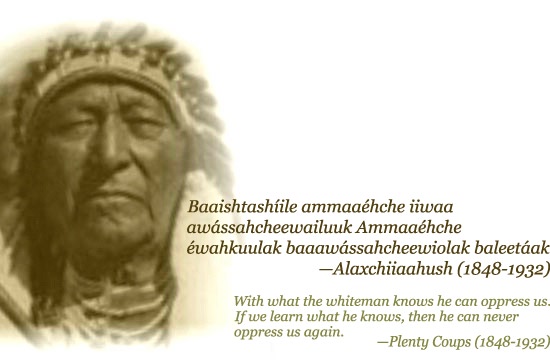Lesson Plans

Maybe if we learned more about each other all of Montana’s diverse communities would appreciate, rather than demean their individuality.
Important Apsáalooke curriculum guidelines
First, we must address the issue of the Apsáalooke name. In 1806 a Northwest Territory Company trader by the name of Laroque mistranslated Apsáalooke “Children of the Large Beaked Bird” as Children of the Crow—thus the name Crow became attached to the tribe by non-tribal members. To this day, tribal members call themselves Apsáalooke, it is time for their non-tribal member neighbors to follow suit. Therefore this curriculum offers education about the Apsáalooke, Children of the Large Beaked Bird.
Teach Apsáalooke history as a regular part of your curriculum, these tools should not be used once a year during Native American month or week.
Unless you are an enrolled member of the Apsáalooke Nation avoid relating personal history with the tribe, or the reflections from family members positive or negative regarding tribal heritage. Please avoid any Indian Princess stories; they are not appropriate or educational.
Use books and materials, which are written and illustrated by Apsáalooke people as primary source materials: speeches, songs, poems, and writings, which show the linguistic skill of a people who have come from an oral tradition.
Present the Apsáalooke as appropriate role models to students.
Depict Apsáalooke people in the present as well as the past, and as heroes who are defending their people, rights, and lands.
Use materials, which show respect and understanding of the sophistication and complexities of Apsáalooke society. Understand and impart that the spiritual beliefs of Apsáalooke people are integral to the structure of their society and are not folklore, legend, superstitions or heathen.
Avoid projects making replicas in an attempt to explain housing (tepee model lamps, etc.) dress, weaponry, or tools. Unfortunately there are many books available on this subject—this is a disrespectful way to teach Apsáalooke history and culture. Building a “cute tepee” for play in a kindergarten room or such leads to children “playing at being Indian’. This is neither appropriate nor educational. With the exception of some lady elders who continue to wear moccasins, cotton dresses, leather belts, and a scarf Apsáalooke people no longer wear traditional clothing on a daily basis. An Apsáalooke teacher on the reservation would never consider asking or teaching her students to dress like these elders and pretend to be them. It would be disrespectful and ill mannered. Likewise for their non-Native neighbors it is ignorant to send the message to students that Apsáalooke identity is a costume or art project one can put on and take off. There is nothing educational about asking students to make a headband with feathers and wear it while learning about the Thanksgiving holiday, or Native American week. Apsáalooke do not wear feathered headbands, “war paint’, or wrinkled paper grocery bag clothing.
Do not teach craft activities, which trivialize Native dress, dance, and beliefs, i.e. toilet paper roll “Indian dolls”, paper bag and construction paper costumes and headdresses.
The Apsáalooke no longer live in tepees, some live in frame housing, in neighborhoods with paved streets and basketball hoops in front of their houses, some live in the country, surrounded by nearby family, barns, horses and cows. And many, about 2,000, live off the reservation in Montana communities, across the United States, and the globe.
Understand that many songs, dances, and ceremonies of the Apsáalooke people are considered sacred and should not be “invented” or reenacted as an activity
Do not show movies or documentaries not listed in the enclosed bibliographies. Hollywood and even documentary directors have not often portrayed the Apsáalooke correctly.
Avoid the assumption that an Apsáalooke person knows everything about all Apsáalooke culture.
Apsáalooke students should not be singled out and asked to describe their families’ traditions or their culture.
Do not assume there are not any Apsáalooke students in your class.
Do not use offensive terms such as “papoose”, and “squaw.” Use respectful language. When teaching ABC’s, avoid “I is for Indian” and “E is for Eskimo.” Avoid rhymes or songs that use Native people as counting devices, i.e. “One little, two little, three little...” It is demeaning. Do not use materials that depict the Apsáalooke as “savages,” “primitives,” “The Noble Savage,” “Red Man,” “Red Race,” “simple,” or “extinct.” Present Apsáalooke people as having a unique, separate, and distinct culture, language, beliefs, traditions, and customs. Avoid manipulative phases and wording such as “massacre,” “victory,” and “conquest” which distort facts and history.
Do not use materials which show non-Native Americans or other characters dressed as “Indians.”
Understand that not all Apsáalooke people have “Indian” surnames, but familiar European and Latino names as well.
Help children understand Apsáalooke people have a wide variety of physical features, attributes, and values as do people of all cultures and races.
Most of all, teach children about Apsáalooke people in a manner that you would like used to depict your culture and racial/ethnic origin.
Feel free to invite an Apsáalooke guest speaker/presenter to your class or for a school assembly. Contact the Apsáalooke Nation Chamber of Commerce at 406 638 7272 Apsáalooke Tribe Culture office 406 638 3731 or a Little Big Horn College Crow Studies instructor 406 638 3100. Offer an honorarium or gift to those who visit your school.